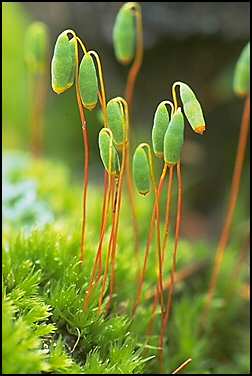Introduction to Mosses

File size:295kb Type:JPG
Mosses preserve the primitive method of sexual reproduction in plants. Moss plants are usually either male or female, although some produce both types of sex organs. The males produce biflagellated sperm that must swim through a film of water to fertilize the ovum hidden in the archegonium of the female plant. The moss plants that produce the gametes (either eggs or sperm) are called gametophytes and have a single set of chromosomes in their cells.
The plant that grows from the union of gametes is called the sporophyte. It has two sets of chromosomes ( one set from each gamete) in its cells,and begins as an embryo retained by the female plant. It actually grows out of the maternal tissue of the archegonium where the egg was fertilized and continues to be nourished by the mother plant while it sends up a stalk topped by a spore capsule (sporangia). Although the moss sporophyte is a plant in its own right, it never achieves full independence from its parent. The sporophyte is usually an annual while the gametophyte that produces it is a perennial. Check out this diagram of the life cycle of mosses.
 Moss plants can also reproduce vegetatively (asexually) by
fragmentation and by producing gemmae (vegetative propagules) in some species.
Moss plants can also reproduce vegetatively (asexually) by
fragmentation and by producing gemmae (vegetative propagules) in some species.
Mosses are very difficult to identify because they are so small. Schofield's books (1985, 1992, see references page) provide clear line drawings which, with the aid of a hand lens, are very helpful. So bear with me while I try to identify some of these organisms. I try to show both leaves and sporangia to aid in identification but this is not always possible. All of the mosses shown are from the Anchorage area.
Many of the meanings of the botanical names of mosses have been taken from Schofield (1992).